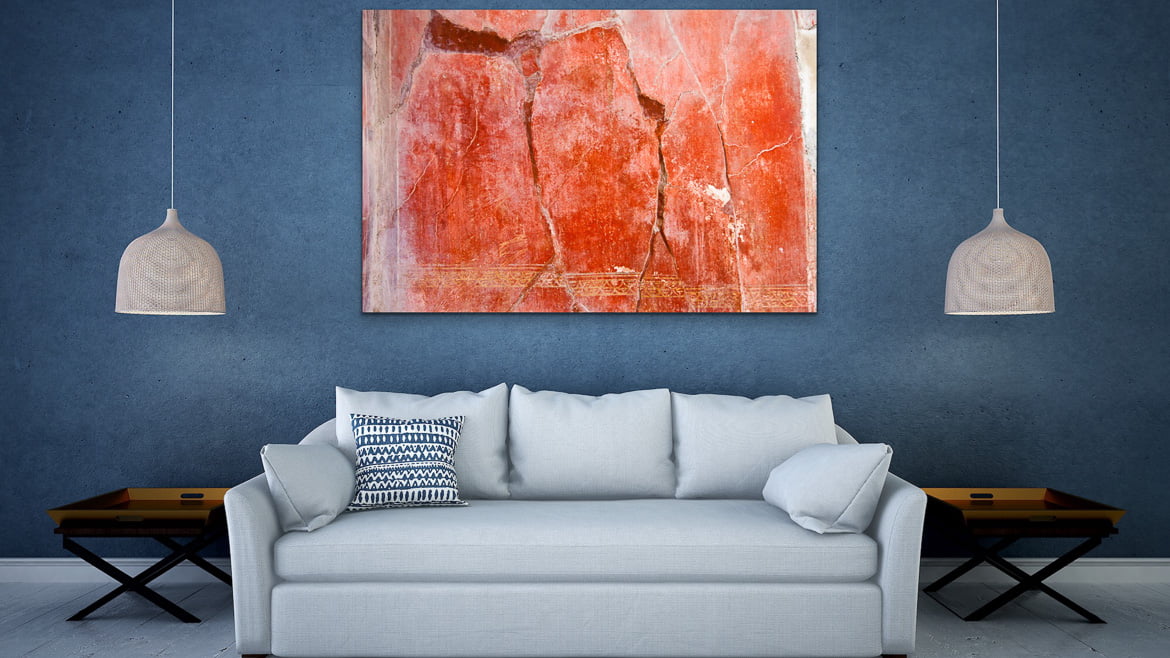The colour known now as Pompeian red was known as Sinopsis in Ancient Roman times. In particular, it was discovered in Ercolano and Pompeii, which are thought to be the most well-preserved cities on account of the "protection" provided by the lava flows. The ancient Turkish city of Sinope is the origin of the term Sinopsis, which was given to this pigment after it was discovered there.
The Pompeian red can be thought of as a natural, iron oxide-based red ochre. Its origin is natural. In modern times, it is also referred to as English red, hematite, terra rossa di Verona, Ercolano red, and terra di Pozzuoli. Because it was discovered for the first time in the exquisite and elegant villas of Roman Patricians, this colour came to be known as the "trademark" of the remains located at Pompeii and Ercolano.
What does the pigment know as Pompeian red look like?
The Pompeian red is not just one colour but a spectrum of colours that vary in the intensity of their red hue. In the beginning, the people who lived in Pompeii would manufacture it with the leftover cinnabar from their work.
On the other hand, due to the high cost of its production, it was only ever employed as a very last resort. After that, the whole thing was changed out because it had a substantial amount of mercury in it, which is extremely hazardous and bad for one's health. Vermillion, red ochre, Mars red, and Rosso Pozzuoli were some of the colours that were gradually substituted for it. Red ochre and Rosso Pozzuoli are both combinations of iron oxides and hydroxides (including the hematite).
What exactly was the hue of the famous Pompeian red?
This lovely colour is famous all over the globe for the walls of Pompeii and the rooms in Ercolano; it's the symbol of a land and a piece of history. Pompeii is located in Italy. In point of fact, current research has shown that the "Pompeian red" would represent a modification of the original colour of the frescos, caused by the gas emissions released by the eruption in 79 A.D.
According to the experts, the walls have taken on a crimson hue as a result of the intense heat and gas produced by the eruption. Because of the effects of this eruption, the pigment in the walls took on a crimson colour. The colour known as Pompeian red is simply a "roasted" form of the yellow ochre.
In point of fact, this "busted myth" has been known about ever since ancient times. In his work, the author Plinio explains that the colour red can be obtained by roasting yellow ochre first. This brings about a permanent change to the colour. Ancient Romans were very familiar with this procedure; hence, it is likely that some buildings turned red as a result of the eruption, while others were already crimson before the eruption.
Pompeian Red Wall Art
You are looking at a close-up of a section of an ancient wall that was found in the ruins of Pompeii. The catastrophic eruption of Vesuvius in the year 79 A.D. buried it forever. The name "Pompeian Red" quickly conjures up images of historic paintings and artists who frequently employed the colour red on houses and public structures in the city of Pompeii, which is now buried under the ash of an eruption. Cinnabar is processed to produce a gradient of red that leans toward ocher of varying intensity (the mineral from which mercury is extracted).
This snapshot, which is an authentic piece of Pompeii's history, can serve as a topic of discussion in the dining room, the kitchen, or even a quiet nook of the living room. It is a hue of red that is simple to combine with other colors such as orange, yellow, green, purple, or burgundy, making it ideal for fashionistas who adore bohemian and eclectic styles.
If you want to add your personal piece of Italian Renaissance to your home, look for breathtaking Fine Art Photographs at Paolo Modena Photography


